Friday Stats and More
Based on the Centers for Disease Control (CDC) Cases in the U.S. website, here is the FEHBlog’s chart of new weekly COVID-19 cases and deaths over the 20th through 40th weeks of this year (beginning May 14 and ending October 7; using Thursday as the first day of the week in order to facilitate this weekly update):

and here is the CDC’s latest overall weekly hospitalization rate chart for COVID-19:

Because the FEHBlog does look at his charts which are intended to show trends, he realized that new deaths chart is flat because new cases greatly exceed new deaths. Accordingly here is a chart of new COVID-19 deaths over the same period (May 14 through October 7 (nearly five months).

Chris Conover recently wrote about your risk of dying from COVID-19 in the Forbes Apothecary. Three takeaways from the article:
- Covid-19 has increased the risk of death for the average American by about 10 percent, but this increase in risk is much higher for seniors than children.
- For seniors age 70 and older, getting Covid-19 is riskier than climbing Mt. Everest; in contrast, for those under age 20, the infection fatality risk is equivalent to driving a car for 7,500 miles.
- Those under age 50 who get infected with the coronavirus lose less than one day of discounted quality-adjusted life expectancy; seniors age 70 or older lose nearly 90 days.
Today the CDC released the first weekly influenza update for this flu season in our country. The key update is brief: “Seasonal influenza activity in the United States remains low.” In contrast, the key update from this week’s COVID-19 update from the CDC is more nuanced:
Nationally, indicators that track COVID-19 activity continued to decline or remain stable (change of ≤0.1%). However, one region reported a slight increase in the percentage of specimens testing positive for SARS-CoV-2 and four regions reported slight increases in the percentage of visits for influenza-like illness (ILI). Mortality attributed to COVID-19 declined but remains above the epidemic threshold.
Today, the CDC also issued its National Action Plan for Combating Antibiotic Resistance 2020-2025, a worthy goal. “The U.S. Government will report annually on progress toward the objectives set in the Plan.”
In his Libertarian podcast this week, law professor Richard Epstein discussed why the Supreme Court will uphold the constitutionality of the Affordable Care Act in the California v. Texas case, which will be argued on November 10. The FEHBlog is buying what the good professor is selling. The discussion is in the first 10 minutes of the podcast which is less than 30 minutes overall.
The HHS Office for Civil Rights took its second scalp this week from a healthcare provider that allegedly failed to give patients HIPAA required access to their medical records, a big OCR priority. “NY Spine Medicine (NY Spine) has agreed to take corrective actions and pay $100,000 to settle a potential violation of the HIPAA Privacy Rule’s right of access provision. NY Spine is a private medical practice specializing in neurology and pain management with offices in New York, NY, and Miami Beach, FL.”
Have a good weekend.







